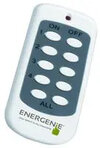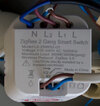My old smart switches (Energenie) passed current through the bulb when off, just a small amount, to power the switch, and they need a load of at least 5 watt. My new smart switches (TP-Link) have a battery in them, and can switch any load even if not 230 volt. The old ones did have an option of a second switch hard wired, the new ones no hard wired option. Both could use remote unit to switch them.
The kinetic range allows switching with what looks like a standard wall switch, using the energy of moving the switch to get the power to switch a relay, but these are not what I would call smart switches, they are not as far as I know programmable or linked to phone.
One can get buttons
View attachment 326588 View attachment 326589wifi linked to switches, or relays, but you need power to the lamp. I use a relay
View attachment 326590 for my landing light, because the location of the switches is not really where I want them. It is also hard wired with a extra low voltage system. but to be frank hardly ever use the manual switches. I use voice commands with google Nest Mini's.
The problem is no two are the same, each has plus and minus points, which are hard to find out about until you buy them. Nearly all need a hub, reason for this is wifi is energy hungry, so using zigbee or other hubs means the devices need less energy to work, so batteries last longer, and bulbs can be smaller without glowing when off etc. So I have ended up with 4 hubs, one needs to be hard wired to router, other three just need mains supply, two double as door bells.
The old Energenie could only have three programmed on/off's unless using ITTT, but does work on the PC direct, the rest need emulators to work with PC they are designed to work with phone or tablet. The TP-Link has dust and dawn functions, and one can program an off or on without having the reverse. So it can be programmed to turn off all lights at 9 am or midnight without any auto on, so it turns off light if you forget.
Bulbs will often allow colour changing and dimming, where switches and relays are simple on/off. The TP-link switch would turn a 12 volt bulb on/off, but most need 230 volt.
You don't make it plain what you are after.




